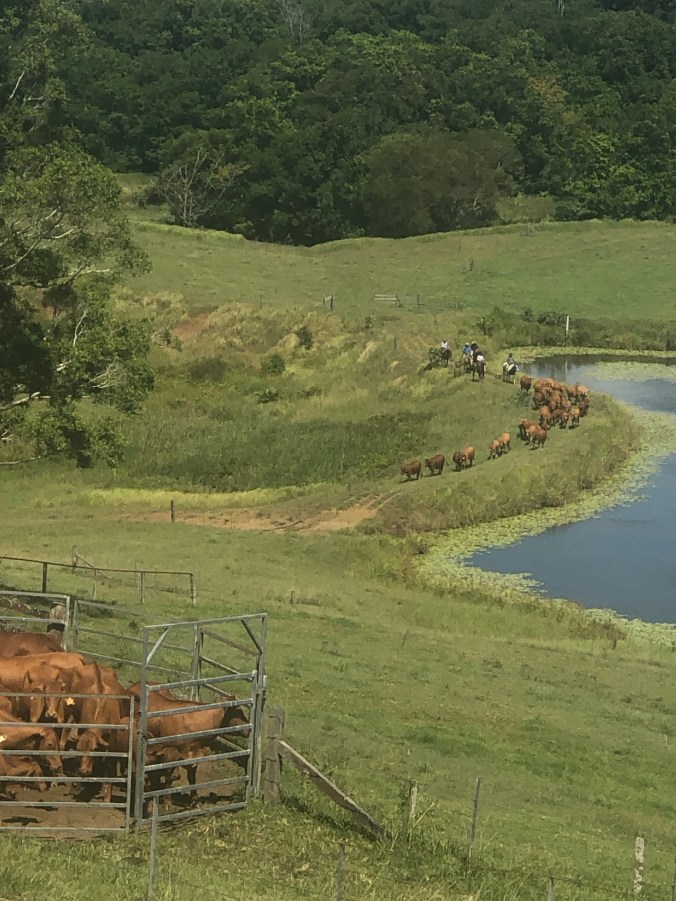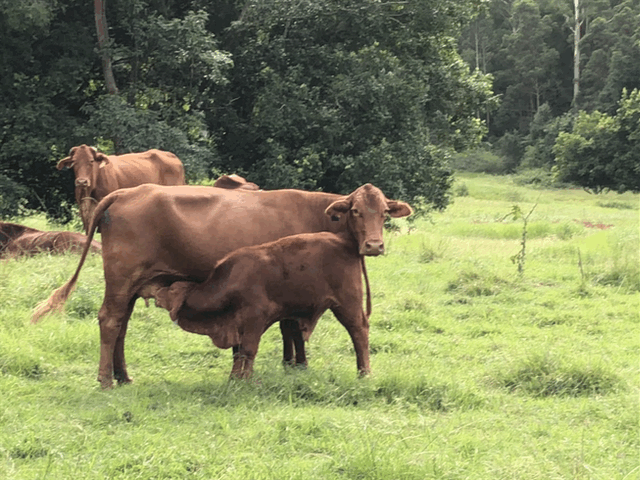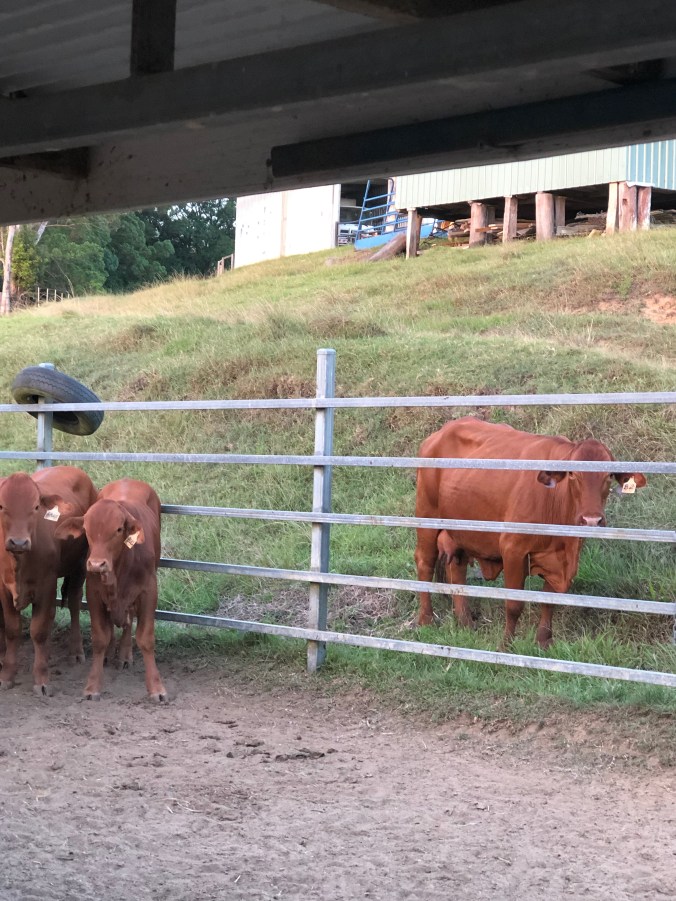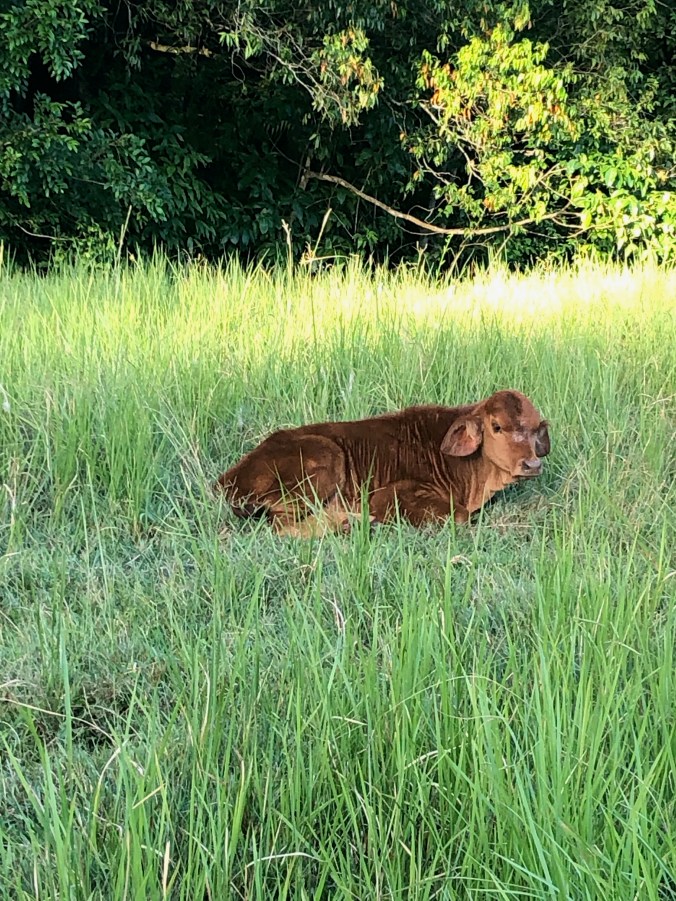My father was an organic farmer and raised beef cattle along with grade B Dairy cows in Minnesota in the 1950s. He died when I was eight years old and my family moved to the city. As a teenager, I became very interested in Eastern thought and at age 18 my fiance and I became vegetarians. We did not want to eat anything we were not willing to kill ourselves, but we never judged others. After 49 years I was left a widow and while traveling in Australia I fell for someone who raises beef cattle. Wal is annoyed by “Greenies” but he puts up with me. While I still can’t bring myself to eat beef I respect the humane way Wal treats his cattle.
One day Wal said, “This weekend we’re going to brand the cattle.” He invited his son and neighbors to come and help. The weather needed to be dry or the branding wouldn’t work. Cyclone Oma was threatening the coast with possible torrential rains, but it veered off to sea. The branding party was on.
The day before we bounced over the green grass hills in four-wheel drive Ute ( utility vehicle). We brought some hay and checked the position of the cattle. When the Ute stopped the cattle gathered around looking for a change in their lush diet of fresh grass. As he threw the hay off the back of the Ute they happily grabbed a bite. He wanted to encourage them to stay where they were. As we returned Wal adjusted the gates to make driving the cattle to the corral easier.
The next morning I put on my jeans and we had a big breakfast. Wal went out to saddle the horses. We’d decided I was too inexperienced a rider to help drive the cattle. That was a relief since I had no idea, what really was going to happen or how I’d feel about it.. Wal and four neighbors along with Banjo a six-month-old cattle dog in training rode off to round up the cattle.
I hid out in the shed with my camera ready in video mode as the first mob came bounding in. Banjo was a little too excited about his first job and had to be called back to keep him from chasing the cattle into a run. With Banjo dismissed the next mob came in calmly:
When all the nearby cattle had been rounded up the riders took off to the far side of the farm to drive the others home. Banjo was again given a chance to help and this time he walked calmly. The scene was straight from an old west movie only I was seeing it in three dimensions. The cattle appeared moving out in the valley by the dam:

If you examine the photo carefully you will see Banjo walking next to the lead horse. The cattle are calmly walking towards home from the far side of the paddock. They continued single file and came in the corral calmly.
After all of the cattle are rounded up they are carefully counted and examined individually. They are encouraged and sometimes prodded into the squeezebox. Although some of the young ones are confused by the process, most seem to calmly accept what is happening. One by one they go through and their numbers are checked off. Each one has an ear tag with a number, a brand on their side and their ears are clipped to show they belong to this ranch:

Ear clipping and tags are like my own experience of getting my ears pierced, not great but not too bad either, but I’m not sure about branding. Some of the young steers have not been branded yet so Wal heats of the branding iron to burn it into their sides. I winced at the idea of it. Wal used a gas burner and carefully heated the branding iron,
much like a curling iron might have been heated years ago, only hotter. He was very quick as he applied it to the calf in the holding pen. The calf winced but did not bellow out. I was surprised at how quickly it went and how stoic the calf was, and I was during the whole process. After being tagged and branded, a tick insecticide was applied to their backs. Bush ticks are ferocious in Queensland and can severely weaken a young calf, plus another tick called a paralysis tick can paralyze and kill a calf. The large calves were separated from their mothers to be weaned. These calves were really big, not babies like in the case of milk cows. These teenaged cows were happy to go be with their buddies:

This calf has just been released from the squeezebox and is going to be with the other teenagers to be weaned. Younger calves were allowed to go back out to the pasture with their mothers. Here is a mother cow with one of her big babies out in the field before they were weaned. She’s a bit tired of this big baby, but wouldn’t think of refusing him:

I felt for the mother and the baby remembering when I’d weaned my children. I had to wean my son when I just couldn’t eat enough to keep going, yet it wasn’t easy. The teenaged cows really didn’t seem to mind being weaned, they liked being together and really liked the hay and grain they got in the corral. It was their mothers that had a hard time with it. They came up to the fence full of milk and called for their calves to come back to them.

Mom wants her baby back, but the teenagers really aren’t that interested
I remembered that too, when full of milk and just wanting to nurse again when I weaned my son, but soon I dried up and had lots more energy when I wasn’t constantly eating for two. I’m sure the cattle soon felt the same.
Wal watches over his cattle and when a calf was lost, the mother calling for her baby he went out to look for it. He found a little calf down on the ground unable to get up. It had a paralysis tick on it. Wal removed the tick, but the calf was too weak to get up, so he couldn’t bring it back to the mother. He brought back to the stable and was able to nurse it back to health. 817 the steer that should have died is almost as big as his brothers.

817 was an unusual case, usually, Wal says sadly its” Livestock, deadstock.” We found a calf down during the muster and we tried to bring it back to the stable. It had been abandoned by its mother and was very weak:

He managed to stand up and even walked back to the stable, but he was unable to suckle or eat. He laid down in the hay and was dead the next morning. I felt very sad.
The cattle at Long Timber lead a happy life. The bull is very attentive to his girls. Here he is following a female who will soon be in heat. There is a light warm Australian rain falling. He may look big and lumbering but he is, “quick as a cat.” says Wal.
I didn’t see him mount her, but I’m sure he does it often with the number of happy calves jumping around in the paddocks. These are Australian beef a cross between a Bos Taurus a British breed and Bos Indicus Asian cows. They do very well in the extreme Australian climate.

These gentle animals have been raised by humans for centuries, and here on this farm, they lead a good life, with just a few bad days at the end.
Now that I’m lived longer and seen death, it is no longer an evil thing, it just is. Plants, animals, and people live and die. Some survive through sunlight water and soil, others need to eat other living things. But for me, I need to know that whatever I eat had a healthy happy life. Therefore I try to eat organic fruits and vegetables and I avoid any animal that has had to be in a CAFO [Concentrated Animal Feeding Operation).
There are lots of CAFOs in Wisconsin near my home. The animals are crowded together and fed grain rather than grass, they are given antibiotics and growth hormones to fatten them up faster. The CAFOs pollute the groundwater with nitrogen from the manure so that many homes have well water that cannot be used. In the US in 2011 78% of the beef was from feedlots, and I assume it is higher today. In Australia also 80% of the beef is finished off in feedlots.
Very interesting patsy – the animals look very happy there. Well written )
LikeLike